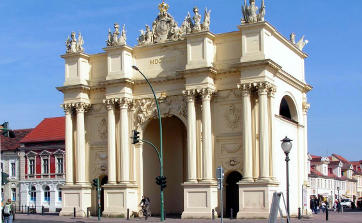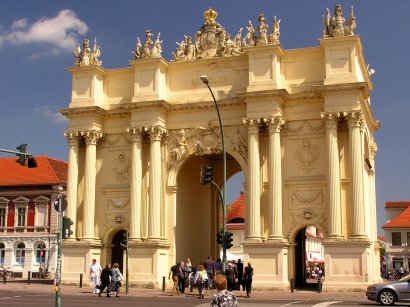Brandenburg Gate (Potsdam)
The Brandenburg Gate on Luis place in Potsdam, not to be confused with the symbol of the city of Berlin at the city's Pariser Platz was built in 1770/71 by Carl von Gontard and Georg Christian Unger on behalf of Frederick II. It stands on the western end of the Brandenburger Straße, which runs in a straight line to the Church of St. Peter and Paul.
Earlier, in 1733, there were in the same location to another, a simpler gate that resembled a castle gate. Together with the city wall, a kind of customs or excise wall wall, and the other ports it should prevent the desertion and smuggling.
Towards the end of the Seven Years' War Frederick the Great erode the old gate, and at this point a new, Brandenburg Gate, built as a sign of victory. For this reason, the Brandenburg Gate also a Roman triumphal arch looks similar. Was modeled on the Arch of Constantine in Rome. The Roman influence in the architectural style is recognizable among other things, in the Corinthian double columns and in the strong cranked beams.
Characteristic of the Brandenburg Gate are its two completely different designed pages, which go back to two architects Karl von Gontard created the city pages, his pupil Georg Christian Unger the field or land side. Gontard designed the city side as plaster facade with Corinthian pilasters and trophies, Not the side of the field based on the Arch of Constantine with Corinthian columns and ornaments double as the golden trumpets. The two lateral passages for pedestrians were under Frederick William IV added only in 1843 to meet the increased Passieraufkommen justice.
You had to time the Brandenburg Gate happen if you wanted to go on the road to city of Brandenburg, hence the name. The gate takes the walker through the downtown pedestrian zone Brandenburg Road in an easterly direction to the Peter and Paul Church.
Since the demolition of the city walls in 1900 the Brandenburg Gate is a freestanding structure.










